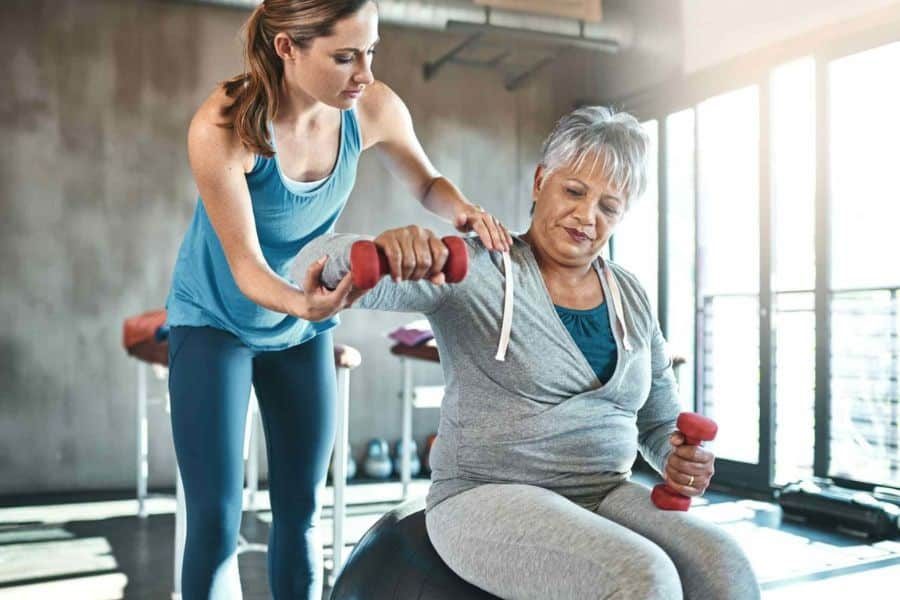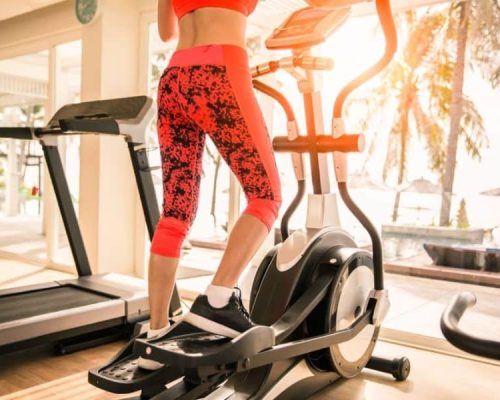Benefits of Strength Training for Seniors
Strength training for older folks is like finding hidden treasure. It helps you build new muscle, keep your bones strong as iron, and gives you the zest to do everyday stuff without feeling like you’re running on empty. Let’s explore how these exercises can add more pep to your step as you age.
Muscle Building and Strength
Your muscles are like loyal pals that need a bit of love to stay with you. As the years go by, muscles can pack up and leave, thanks to a little thing called sarcopenia, a condition making this an inevitable part of growing older. But with some grit and determination, anyone can tell it to take a hike. Strength training, whether it happens in your living room with resistance bands or at your trusty local gym, is your secret weapon. Keep your body limber and ready for anything by penciling in those squats and curls weekly.
| Exercise | Repetitions | Sets | Frequency |
|---|---|---|---|
| Bodyweight Squats | 10-15 | 2-3 | 2-3 times per week |
| Resistance Band Rows | 10-15 | 2-3 | 2-3 times per week |
| Dumbbell Bicep Curls | 10-15 | 2-3 | 2-3 times per week |
Bone Density Preservation
Bones get a bit frail with age, and osteoporosis can sneak in when you’re not looking. But hey, no need to freak out! Strength training keeps your bones tough and ready for action. Pumping some iron or even low-impact workouts can nudge your bones to stay healthy and strong. So why not try those leg exercises that have less bounce and more benefits? They’re easy on the joints but pack a punch for bone density.
Improving Independence and Vitality
Being able to tackle daily tasks without a hitch is what keeps you feeling young at heart. Keeping those muscles and bones in top shape means fewer slips, trips, and spills — and who doesn’t want that? You’ll find you’re not just living life but grabbing it with both hands, thanks to improved sleep, lifted spirits, and energy to spare. Toss in some balance and coordination exercises to keep your footing sure and steady.
Mixing functional movements into your routine makes you ready for whatever the day throws your way, be it grand adventures or just a jaunt to the store. Curious about where to begin? Check out our suggested workouts for more tips and tricks to gear up your strength training game.
Getting Started with Strength Training
Thinking about flexing your muscles in the strength training scene? You’re in for a treat! It’s an awesome way to keep fit and fabulous as you age. Let’s stroll through the starting point, so you’re all set to smash those goals without a hitch.
Importance of Proper Form
Nailing the right form is like finding the perfect dance partner; it keeps things smooth and injury-free. You want to hit those muscles just right and dodge any pain. Trust me, kicking off with exercises that let you laser-focus on technique lays the groundwork for greatness.
Quick hits to keep in mind:
- Don’t rush; slow and steady wins the race.
- Stand tall and proud; keep your back comfy and straight.
- Remember: Don’t lock those knees and elbows.
Grabbing some time with a personal trainer or joining a senior class can be a game-changer. They give you that on-the-spot advice and the confidence needed before taking it up a notch.
Bodyweight Exercises for Beginners
Kicking off with your body weight is like training wheels for your fitness bike. It helps you find your groove without needing fancy gear. Plus, it’s a killer way to nail your form before leveling up to weights (SilverSneakers).
Try these no-equipment wonders:
- Squats: Great for your legs and abs.
- Modified Push-ups: Tones up the arms and chest.
- Planks: Keeps your midsection solid.
- Chair Stands: Boosts balance and leg strength.
- Wall Push-ups: A friendly intro for the uninitiated.
| Exercise | Target Zone | Repetitions | Sets |
|---|---|---|---|
| Squats | Strong Legs | 10-15 | 2-3 |
| Modified Push-ups | Built Arm Zone | 8-10 | 2-3 |
| Planks | Abs a Go-Go | Hold 20-30 sec | 2-3 |
| Chair Stands | Leg Magic | 10-15 | 2-3 |
| Wall Push-ups | Arm Love | 10-15 | 2-3 |
For exercises that really zoom in, our lower-body strength training exercises and upper-body strength training exercises guides are your go-to resource.
Progression to Weighted Workouts
Once you’re comfy with bodyweight exercises, it’s time to grab some weights. Dumbbells, resistance bands, or even a couple of water bottles can do the trick. Adding weight boosts muscle and bone strength—pretty key as the clock keeps ticking (Live 2 B Healthy).
Begin with light weights to make sure your form stays on point. Here are some tips for a slick transition:
- Select a weight you can use for 10-15 reps with your A-game form.
- Step it up gradually, lifting heavy as you get stronger.
- Go for big moves, like deadlifts and rack pulls (Starting Strength).
- Bands are your friend for an adaptable and safe workout.
| Exercise | Weight in Pounds | Repetitions | Sets |
|---|---|---|---|
| Dumbbell Squats | 5-10 | 10-15 | 2-3 |
| Bicep Curls | 3-5 | 10-15 | 2-3 |
| Deadlifts (Rack Pull) | 10-15 | 8-10 | 2-3 |
| Tricep Extensions | 3-5 | 10-15 | 2-3 |
| Shoulder Press | 5-8 | 10-12 | 2-3 |
Keeping your workout schedule regular not only helps you build strength but wins you bonus points for health benefits that last a lifetime. For the lowdown on sticking with your routine, check out our recommended workout schedule. Happy lifting!
Equipment for Seniors
When you decide to pump up that strength training routine, having the right stuff is a game-changer. Let’s chat about simple yet awesome tools that’ll get seniors flexing those muscles: resistance bands, some smart swaps for traditional weights, and wallet-friendly workout ideas.
Benefits of Resistance Bands
Alright, let’s talk stretchy bands! Resistance bands are pretty much the bees’ knees for anyone kicking off strength training, especially seniors. According to our friends at SilverSneakers, here’s why these bands are pure gold:
- Flexibility: Whether you’re aiming to beef up those biceps (upper body strength training exercises) or wanna get your legs moving (lower body strength training exercises), these bands got your back.
- Gentle on Joints: Who needs that bone-crunching weight when bands can give you resistance minus the ouch?
- Portable: Toss ’em in your backpack, have a quick workout sesh at home (strength training exercises at home) or even while traveling.
| Exercise Type | What Bands Do for Ya |
|---|---|
| Upper Body | Bendy resistance, joint-friendly |
| Lower Body | Portable, different resistance levels |
| Full Body | Cheap and handy |
Alternatives to Free Weights
Dumbbells and barbells are like the jocks of strength training, but let’s introduce you to their chill cousins:
- Resistance Bands: Yup, brought ’em up already ’cause they’re super flexi.
- Weighted Balls: These are like a friendly hug for your joints while adding some muscle magic.
- Ankle Weights: Perfect for those with a focus on lower body gains without the hassle of hand-holding weights.
If you’re wrestling with health stuff, these tools from Live 2 B Healthy can make exercises calmer yet effective.
Cost-Effective Workout Options
No need to empty your pockets for fitness gains. Here’s some nifty tricks:
- Bodyweight Exercises: Squats, lunges, and push-ups cost zippo and deliver big time.
- Homemade Weights: Hey, that’s just your water bottles or canned goods doubling as gym equipment.
- Resistance Bands: Cheap and multifaceted, these bands are a keeper.
For step-by-step DIY workout techniques, hop over to our handy-dandy guide on strength training exercises at home.
Mix these tools and alternates into your training lineup, and you’re set to smash those fitness goals with flair and care.
Recovery and Adaptation
Prioritizing Muscle Recovery
Muscle recovery ain’t just a nice-to-have for old-folks doing strength training exercises—it’s a must. As the years pile on, our bodies naturally take a bit more time to bounce back post-workout, so giving those muscles a breather is key. Not only does adequate rest help you snag better results from your sweat sessions, but it also cuts down the risk of injuries and boosts health across the board (SilverSneakers).
| Age Group | Recommended Recovery Time |
|---|---|
| Younger Adults | 48 hours |
| Seniors | 72 hours |
According to McLester and his pals (2003), even the buffest folks—regardless of age—see the best muscle recovery after a good 72 hours (that’s 3 days) instead of the usual 48 hours (Human Kinetics).
Longer Recovery Times as You Age
Time ain’t on your side as you age—especially when it comes to muscle recovery. A slowdown is due to various reasons like less muscle mass and changes in the muscle makeup itself. By grasping these shifts, you can tweak your workout schedule, leaving room for your body to patch itself up and build strength. Giving your muscles room to breathe between sessions means you’re less likely to get those pesky overuse injuries. So, for the more seasoned among us, a 72-hour breather between home strength training exercises is the way to go.
Ensuring Adequate Rest
Getting enough rest? Yeah, it’s more than just a suggestion for those doing strength training. Rest means not just downtime between reps, but also grabbing quality shut-eye and eating right. While you rest up, your body goes to town repairing muscles and building bones—a must for folks dealing with conditions like sarcopenia, where muscle mass takes a hit as you age. Shoot for around 7-9 hours of good sleep nightly to aid recovery and fuel up on the nutrients needed for muscle fix-ups.
For seniors, rest ain’t just a break—it’s a cornerstone for any solid strength training routine, making sure you stick with it and reap the long-term health rewards.
Tailoring Strength Training
Strength training for older adults isn’t a one-size-fits-all deal. It’s about tweaking things to fit everyday life, health quirks, and how steady you feel on your feet. Figuring out these bits and pieces means your workout can be fun, do-able, and do wonders for you.
Functional Movements for Daily Activities
Adding exercises that mimic your daily motions is key to helping with everyday stuff. These moves target big muscle groups and make regular tasks a breeze. This means things like climbing stairs or lugging bags get less of a hassle. The folks at SilverSneakers reckon playing with the grandkids counts too, and that sounds like a win to us!
A few exercises to try are:
- Squats: Great for getting up from a chair (or the couch).
- Lunges: Makes those stairs less of a mountain.
- Shoulder Presses: Reach up high with no stress.
| Exercise | Daily Activity Function |
|---|---|
| Squats | Standing up, sitting down |
| Lunges | Climbing stairs |
| Shoulder Presses | Reaching, lifting overhead |
Doing these at home? You hardly need any gear, maybe just your own enthusiasm. Check out our guide on strength training exercises at home.
Modifying Routines for Health Conditions
Joint pain and stiffness – sounds familiar? Exercising doesn’t need to hurt. Go for gentler activities that protect those achy areas.
Try these:
- Swimming: Easy on the joints, good for the soul.
- Cycling: Smooth on the joints, good for the heart.
- Chair Exercises: Perfect if you find sitting less of a pain than standing.
If illness has teamed up with aging, talk to a doctor about what’s best for you. They can help make a plan that keeps you moving and healthy.
Balance and Coordination Exercises
Balancing feels trickier with time, but don’t worry; it happens to everyone. Keep tumbles at bay by including balance exercises in your routine. Grab a support bar or chair if needed for safety.
Try these balance boosters:
- Heel-to-Toe Walk: A simple yet effective way to steady your walk.
- Single-Leg Stands: Helps find your footing.
- Tai Chi: Slow and relaxing, great for balance.
Add these gems, and you’ll likely feel more stable during the day-to-day hustle, and that’s a confidence booster right there.
You deserve a workout that keeps up with your pace and needs. From leg exercises to all-around strength builders, check out strength training exercises for legs and best strength training exercises.
By focusing on activities that mimic real-life movements, switching plans to suit your body’s needs, and tossing in some balancing acts, you can enjoy a strength training routine that fits and enhances your life every step of the way.
Training Frequency and Consistency
Alright, let’s talk about getting the best out of your workouts, especially those strength training exercises for the seasoned pros among us – our seniors! Your workout’s success hinges largely on two things: how often you hit the gym and how regularly you show up. So, grab your calendar, and let’s outline your fitness master plan!
Recommended Workout Schedule
The golden rule here is to get your muscles doing their thing about 2 to 3 times every week. Now, interestingly enough, chatting with the science folks, it turns out lifting weights twice a week can be just as solid as doing it three times, especially if you’ve celebrated more than 50 birthdays (Thanks, Human Kinetics). Here’s a friendly schedule you might want to stick on the fridge:
| Weekday | Activity |
|---|---|
| Monday | Lift those weights! |
| Tuesday | Chill or go for a gentle walk |
| Wednesday | Back to the weights! |
| Thursday | Relax or keep it light and breezy |
| Friday | Feeling strong? Another round of weights |
| Saturday | Easy does it or take it easy altogether |
| Sunday | Put your feet up or just a gentle stroll |
Recovery Time for Optimal Results
Giving your muscles a break is like watering your plants – crucial for them to grow! After hitting those weights, you’ll want to rest those muscles for about 48 to 72 hours. It’s all about letting them repair and grow back stronger. If you’re advanced in your workout journey, listen to your body if it asks kindly for more than two days off.
| Training Level | Recommended Recovery Time |
|---|---|
| Beginner | 48 hours to kick back |
| Intermediate | 48-72 hours, extra nap time |
| Advanced | 72+ hours, more cookies please |
Importance of Consistent Training
Sticking to your routine is a bit like feeding a puppy – consistency does wonders. Skip those training days, and your muscles may not adapt well to the hustle. Don’t forget, training the same muscles on back-to-back days is like trying to run before you walk! Keep those muscles resting and growing strong (Human Kinetics).
To keep things snappy and fail-proof, mix up your exercises! Listen, pull in a few upper body moves with some lower body favorites to keep things fresh and keep you coming back for more.
So, by keeping your workouts structured, making sure you’re not skipping on rest, and you’re actually sticking to that plan, you’re doing more than just lifting weights – you’re building stronger muscles, keeping those bones sturdy, and elevating your overall health game. Keep lifting, keep thriving, and most importantly, keep smiling!










